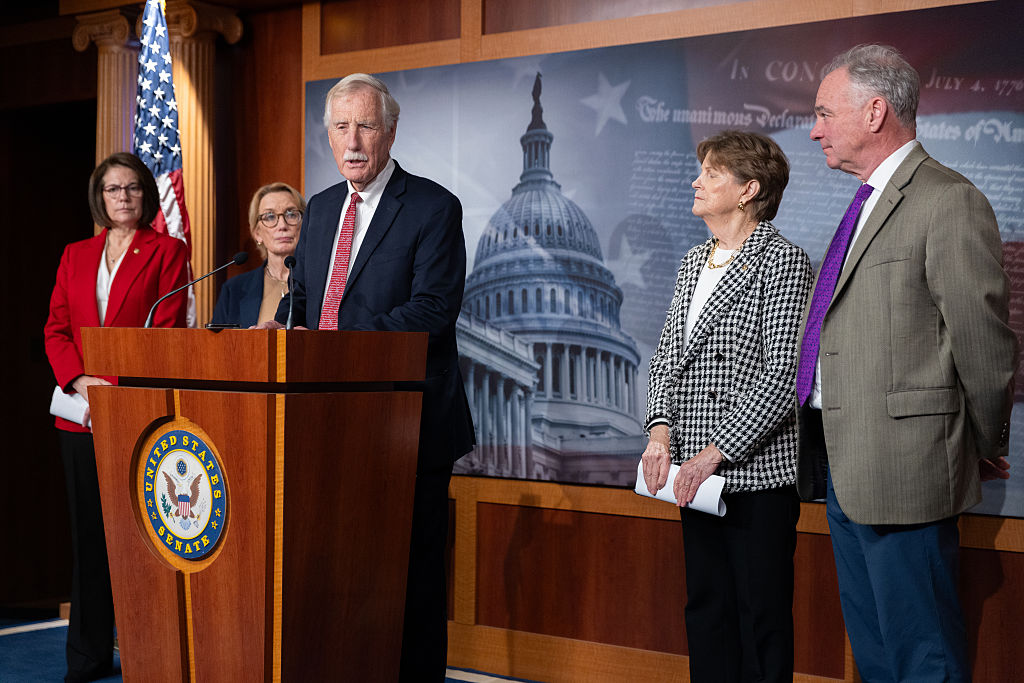This is Day 41 of the government shutdown. It’s likely to end this week, although the final chapter may be slower — and dumber — than everyone hopes.
The latest. The Senate voted 60-40 late Sunday to move forward with a stopgap funding bill to reopen the government through Jan. 30, combined with a three-bill minibus covering FY2026 funding for MilCon-VA, Agriculture and the Legislative Branch. This package includes language reversing the mass firing of federal workers during the shutdown and barring future layoffs through Jan. 30.
This was a huge moment. Eight Senate Democrats broke with the party in voting to end the shutdown in exchange for a commitment from Senate Majority Leader John Thune to hold a vote by mid-December on expiring Obamacare subsidies — an offer Thune first made weeks ago. Senate Minority Leader Chuck Schumer, who’s faced tremendous criticism from both the left and right during the impasse, was a no. That’s not saving Schumer from progressive fury, however.
The Senate will come in at 11 a.m. today. While senators hope to finish voting on the CR-minibus package today to get home in time for Veterans’ Day on Tuesday, that would require consent from all 100 senators.
Then the House will need to take up the package. This could be Wednesday or Thursday. Much more on this below.
We’ll note that GOP leaders are now saying House members will get 36 hours — not 48 hours as previously promised — before any floor votes. But if you’re a House member, you should just start heading for Capitol Hill right now, just in case.
Dems’ dilemma. The endgame of the shutdown is a major challenge for Schumer and other Democratic leaders, who now have to manage a situation where they may privately agree with the outcome but are publicly opposed. The base is very angry at Schumer — again — even though he voted with them.
Most Senate Democrats were seething after a two-and-a-half-hour caucus meeting on Sunday night, lamenting that the handful of their colleagues providing the votes to reopen the government were making a huge mistake.
Democrats saw last week’s election victories as a validation of their shutdown strategy that put them in an even stronger position. President Donald Trump said the shutdown has been “worse for us than for them.”
“It would be a policy and political disaster for Democrats to cave,” Sen. Bernie Sanders (I-Vt.) said. “Essentially, if Democrats cave on this issue, what it would say to Donald Trump is he has a green light to go forward toward authoritarianism. And I think that would be a tragedy for this country.”
Yet it was also painfully obvious after 40 days that Senate Republicans weren’t going to engage on the Obamacare subsidies until the shutdown was over. Plus, Trump won’t go over the heads of Thune and Speaker Mike Johnson to cut a deal with Schumer and House Minority Leader Hakeem Jeffries, no matter how much they tried to goad him. In short, the Democrats’ strategy didn’t work here.
And let’s be honest — there’s a big contingent of Democratic senators who would’ve never voted to open up the government.
The eight Senate Democrats who voted to end the shutdown saw it this way: The party’s shutdown strategy wasn’t working, and there was no evidence that prolonging the impasse would force Republicans to the table. Not even Schumer could convince them otherwise.
“Most of us up here… have voted repeatedly with the Democratic strategy,” Sen. Tim Kaine (D-Va.) said. “But after 40 days, it wasn’t gonna work.”
Sen. Jeanne Shaheen (N.H.), one of the lead Democratic negotiators, said it was clear that “there was no vote” they’d get on Obamacare while the government remained closed. With Thune’s commitment, Sen. Angus King (I-Maine) added, “there’s a lot better chance” to get something done.
This group wants to work with Republicans to craft a health-care bill that could get 60 votes — although there’s no guarantee of a House vote. These Senate Democrats have already been exchanging potential legislative language with Republicans, including Sen. Bill Cassidy (R-La.), who chairs the Senate’s health committee and told us he’s planning to hold hearings.
It’s also worth noting that Democrats still have some leverage. They could try to shut down the government again on Jan. 30 if they feel their demands haven’t been met. Shaheen said Sunday that that could be an option.
Schumer fallout. From the beginning of the shutdown fight, it was clear that Schumer wouldn’t emerge unscathed. Even though he opposed the shutdown-ending deal, Schumer was criticized for being unable to hold his caucus together.
The fury at Schumer and the eight other Senate Democrats was palpable on Sunday, both on social media and inside the Democratic Caucus. A number of 2026 Democratic Senate candidates — none of whom Schumer recruited — were calling for his ouster or saying they wouldn’t vote for him as Democratic leader if they won.
We asked Sen. Elizabeth Warren (D-Mass.) whether Schumer “had done a good job here.”
After a lengthy pause, Warren responded: “I think the American people want us to stand and fight for health care. Obviously, that’s not happening.”
Yet shutdowns almost never yield real legislative wins for the side instigating them – in this case, Democrats – and Republicans didn’t want to break with that precedent. Schumer believed public pressure would force Trump and Republicans to extend the Obamacare subsidies. In the end, Republicans never buckled.
The shutdown was also beginning to hurt some of the very groups Democrats say they fight for, including millions of SNAP and federal aid recipients.
There’s one more thing — it also achieved a key political goal for Democrats, which was to elevate health care as a central issue for 2026.





